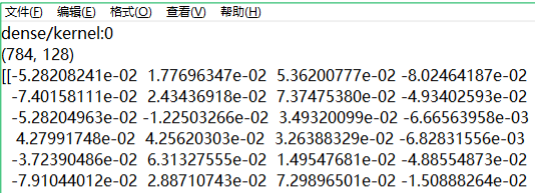1.提取可训练参数
model.trainable_variables模型中可训练的参数
2.配置print的输出格式
np.set_printoptions(precision=小数点后按四舍五入保留几位,threshold=数组元素数量少于或等于门槛值,打印全部元素;否则打印门槛值+1 个元素,中间用省略号补充)

注:threshold=np.inf 可以打印全部数组元素


模型参数打印结果:

weights_mnist.txt

完整代码
import tensorflow as tf
import os
import numpy as np
np.set_printoptions(threshold=np.inf)
mnist = tf.keras.datasets.mnist
(x_train, y_train), (x_test, y_test) = mnist.load_data()
x_train, x_test = x_train / 255.0, y_train / 255.0
model = tf.keras.models.Sequential(
tf.keras.layers.Flatten(),
tf.keras.layers.Dense(128, activation='relu'),
tf.keras.layers.Dense(10, activation='softmax')
)
model.compile(
optimizer='adam',
loss=tf.keras.losses.SparseCategoricalCrossentropy(from_logits=False),
metrics=['sparse_categorical_accuracy']
)
checkpoint_save_path = './checkpoint/mnist.ckpt'
if os.path.exists(checkpoint_save_path + '.index'):
print('--------------- load the model ---------------')
model.load_weights(checkpoint_save_path)
cp_callback = tf.keras.callbacks.ModelCheckpoint(filepath=checkpoint_save_path,
save_weights_only=True,
monitor='val_loss',
save_best_only=True)
history = model.fit(x_train, y_train, batch_size=32, epochs=5, validation_data=(x_test, y_test), validation_freq=1,
callbacks=cp_callback)
model.summary()
print(model.trainable_variables)
file = open('./weights_mnist.txt')
for v in model.trainable_variables:
file.write(str(v.name) + '
')
file.write(str(v.shape) + '
')
file.write(str(v.numpy) + '
')
file.close()